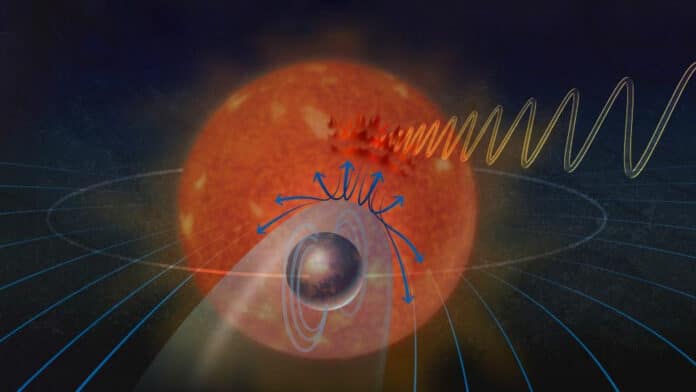The atmosphere of a planet can be protected from particles ejected from its star by the magnetic field of that planet. Whether a planet has a strong magnetic field can affect whether it can support life with an atmosphere.
Now astronomers have discovered an exoplanet as a prime candidate for also having a magnetic field — YZ Ceti b. Located about 12 light-years away from Earth, YZ Ceti b is orbiting a star YZ Ceti.
Scientists have observed a repeating radio signal emanating from the star using Karl G. Jansky Very Large Array, a radio telescope operated by the U.S. National Science Foundation’s National Radio Astronomy Observatory.
Jackie Villadsen, an astronomer at Bucknell University, said, “I’m seeing this thing that no one has seen happen before.”
She recalls the moment: when she isolated the radio signal while pouring over data at her home on the weekend.
Sebastian Pineda, an astrophysicist at the University of Colorado, said, “We saw the initial burst, and it looked beautiful. When we saw it again, it indicated that, OK, maybe we have something here.”
The interactions between the exoplanet’s magnetic field and the star it orbits are thought to be the source of the stellar radio waves that astronomers discovered. These radio waves must be pretty powerful, though, to be picked up over great distances. While magnetic fields on giant Jupiter-size exoplanets have been previously discovered, a different method is needed to do so for a relatively small Earth-sized exoplanet.
The small red dwarf star YZ Ceti and its known exoplanet, YZ Ceti b, provided an ideal pair because the exoplanet is so close to the star that it completes a full orbit in only two days. As plasma from YZ Ceti careens off the planet’s magnetic “plow,” it then interacts with the magnetic field of the star itself, which generates radio waves strong enough to be observed on Earth.
Villadsen said, “Because magnetic fields are invisible, it’s challenging to determine if a distant planet has one. What we’re doing is looking for a way to see them,” she says. “We’re looking for planets that are close to their stars and are a similar size to Earth. These planets are way too close to their stars to be somewhere you could live, but because they are so close, the planet is kind of plowing through a bunch of stuff coming off the star.”
“If the planet has a magnetic field and it plows through enough star stuff, it will cause the star to emit bright radio waves.”
The interactions between YZ Ceti b and its star also produce an aurora, but with a significant difference: The aurora is on the star itself.
Pineda said, “We see the aurora on the star — that’s what this radio emission is. There should also be aurora on the planet if it has its atmosphere.”
“Both researchers agree that while YZ Ceti b is the best candidate yet for a rocky exoplanet with a magnetic field, it’s not a closed case. This could plausibly be it. But I think it will be a lot of follow-up work before a really strong confirmation of radio waves caused by a planet comes out.”
Journal Reference:
- Pineda, J.S., Villadsen, J. Coherent radio bursts from known M-dwarf planet-host YZ Ceti. Nat Astron (2023). DOI: 10.1038/s41550-023-01914-0
